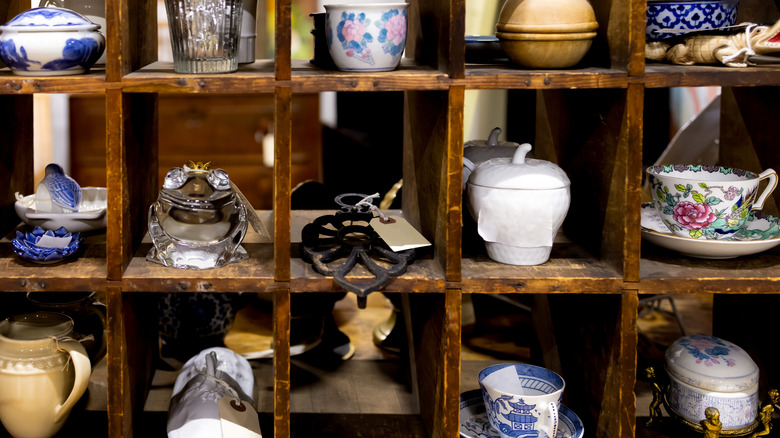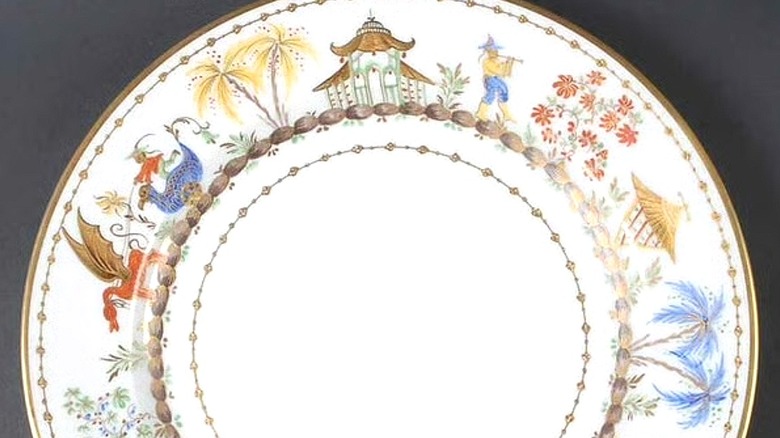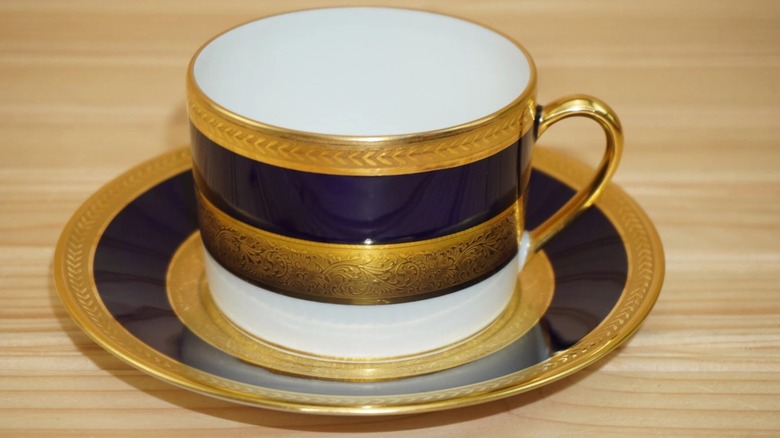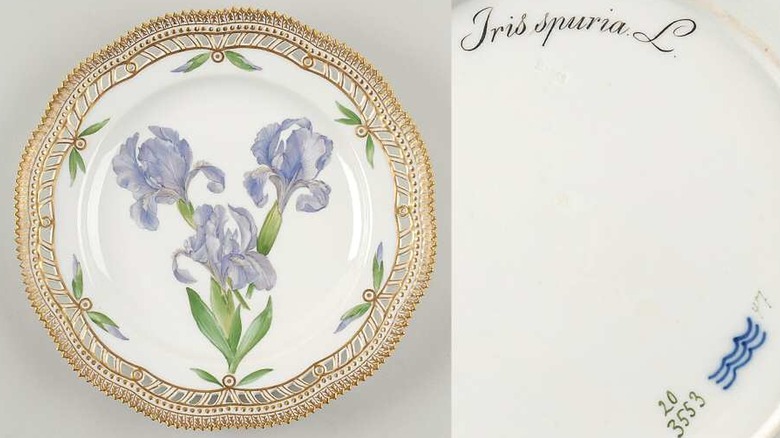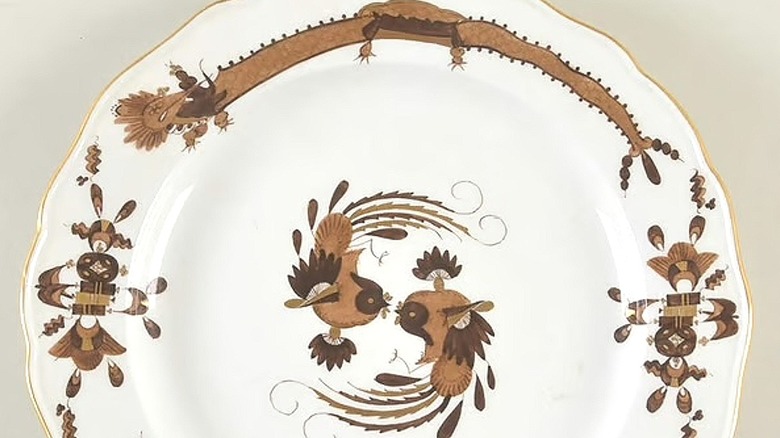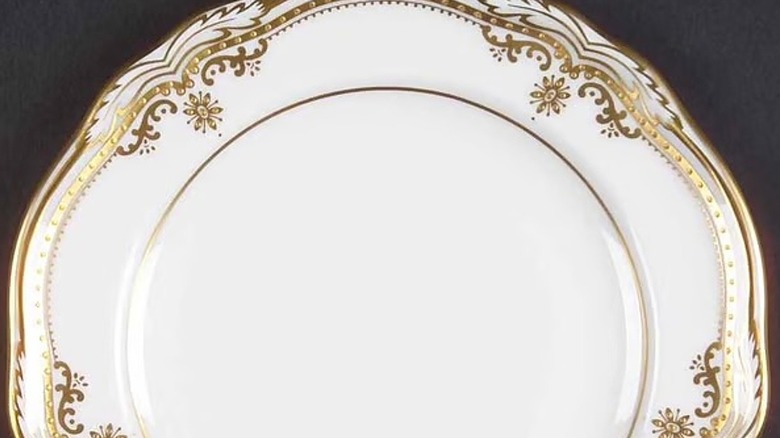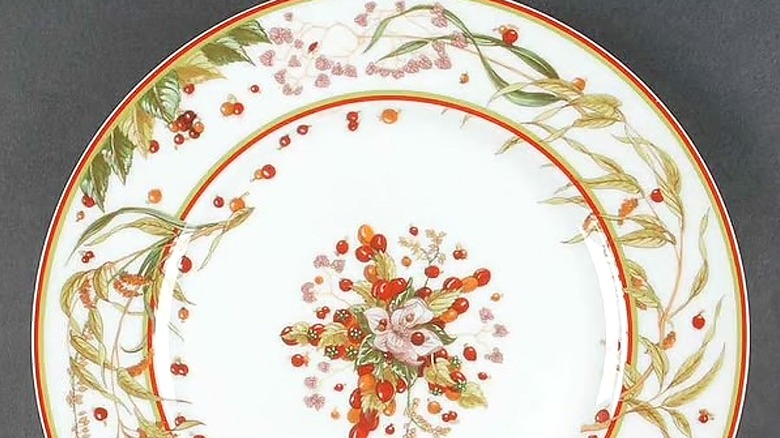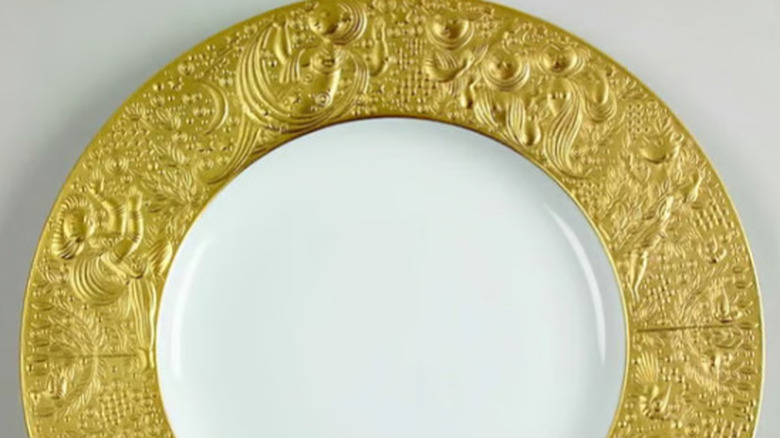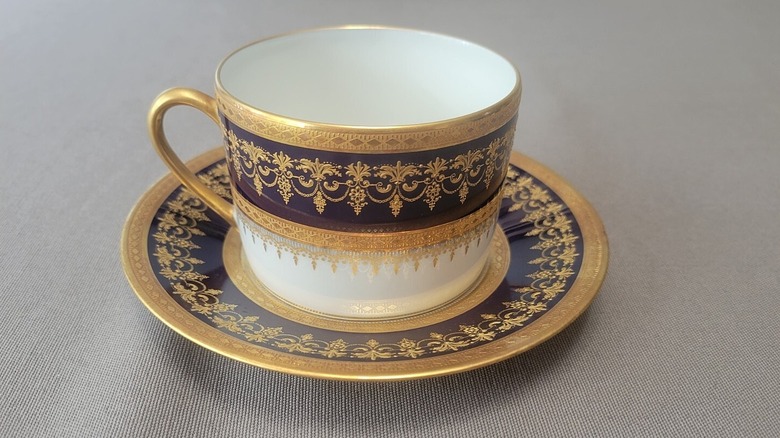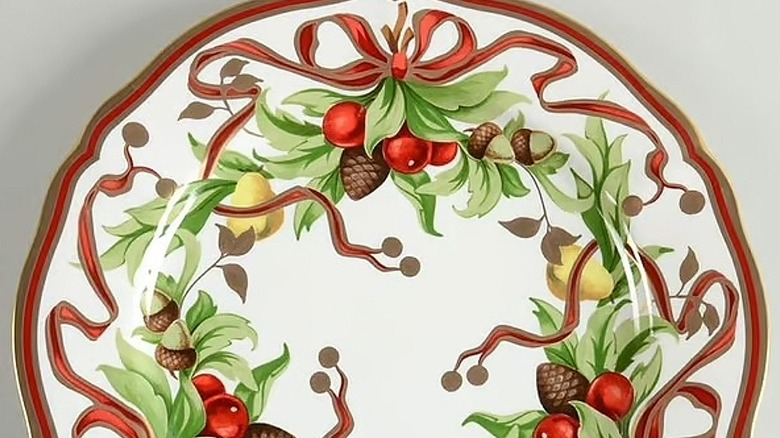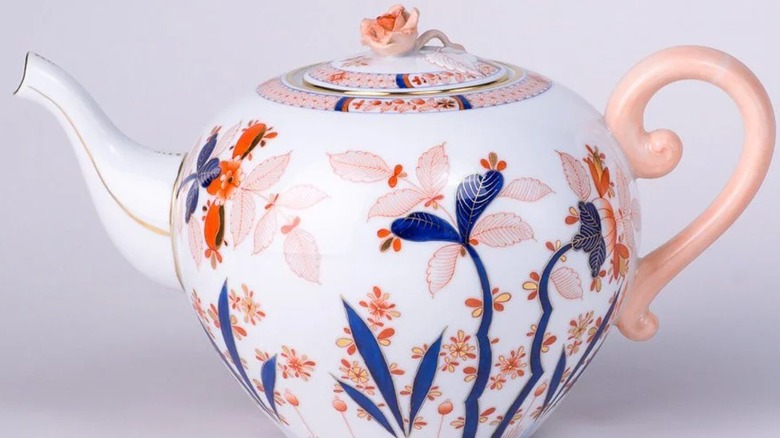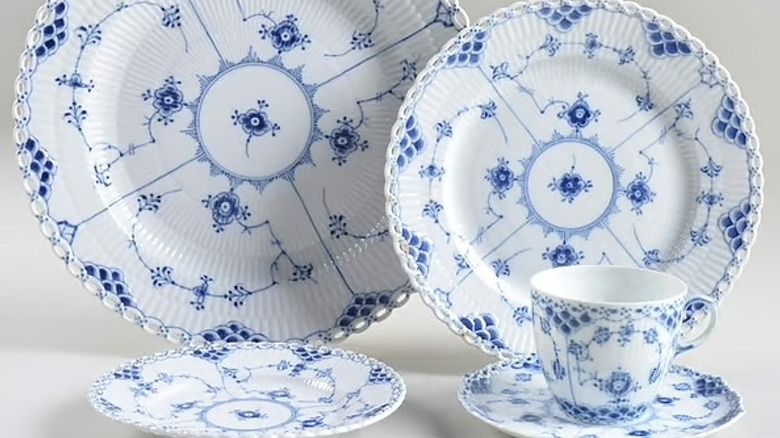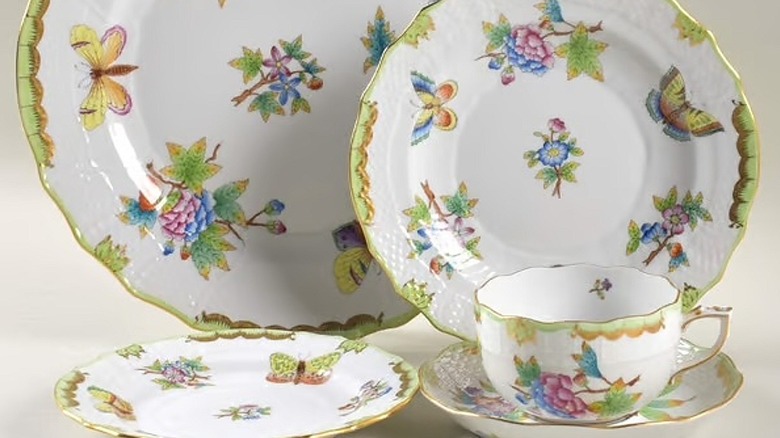13 Valuable Patterns Of Vintage China You'll Want To Look Out For When Thrifting
There's an instant thrill to thrift shopping — wandering the aisles, scanning dusty shelves, and suddenly spotting something that makes your heart skip a beat. Perhaps it's a delicate teacup with gold trim or a plate adorned with soft, hand-painted florals. Vintage china is one of those covetable categories that blends beauty, nostalgia, and, sometimes, surprising value. Whether you're hunting for a rare piece to resell, hoping to build a one-of-a-kind collection, or love the idea of adding character to your kitchen cabinets, having an idea of which patterns to look out for can seriously level up your game.
You don't have to be an expert to spot the gems. With a little help, it becomes easier to distinguish between everyday dishes and the absolute showstoppers. Some patterns are beloved for their timelessness — think delicate roses, soft gold accents, or intricate blue-and-white scenes — while others stand out because they're bold, quirky, or rare enough to make collectors swoon. It's not as much about the brand as the pattern, so knowing something about china patterns is key.
Names like Royal Copenhagen, Spode, and Hermes pop up frequently, but not all their pieces are collectible. A certain backstamp, color variation, or production year can make a big difference. And then there are the true unicorns, like Tiffany's whimsical Cirque Chinois or Shelley's Dainty Blue bone china teacups, that are both incredibly captivating and highly collectible. Find out which treasured patterns you should look for next time you're thrifting.
Cirque Chinois by Tiffany
Tiffany's Le Tallec "Cirque Chinois" china is beloved for its hand-painted patterns that bring the Chinese circus to life. Each piece features colorful, cultural scenes meticulously drawn by hand, including acrobats and dragons. Cirque Chinois china is a favorite for those who love fine porcelain and unique, storybook-like designs. A dinner plate that features red dragons sells for $1,800. So if you find a piece from this collection at your local thrift store, grab it if you're able.
Parthenon by Bernardaud
Bernardaud is synonymous with Limoges porcelain, and the Parthenon design is no exception. The retired pattern features a white and cobalt background with edges adorned in an intricate, rich gold Greek key motif. Inspired by ancient architecture and refined luxury, Parthenon brings eye-popping grandeur to any table setting. Its clean lines and understated opulence make it a fan favorite. A dinner plate can sell for as much as $940.
Flora Danica by Royal Copenhagen
The Royal Copenhagen Flora Danica collection was commissioned in 1790 and retired in 1960. It features hand-painted botanical illustrations based on actual plants from the Danish flora encyclopedia "Flora Danica" and is considered the most opulent porcelain pattern ever designed. Each piece has delicate gold edging and is often adorned with ornate, lace-like details. No two are exactly alike, as every flower is painted by hand with museum-quality precision.
Dragon Brown by Meissen
Featuring bold, hand-painted dragons in rich brown tones — often accented with gold edges — the Meissen Dragon Brown design boasts Eastern influences. As Europe's first and oldest porcelain manufacturer, Meissen has also designed other colorful dragon motifs that are just as collectible, with some, like the Ming Dragon Black china pattern, still in production. A Dragon Brown dinner plate retails for $600.
Stafford White by Spode
The Spode Stafford White collection was produced between 1989 and 2015. The collection features 22-carat-gold accents and a minimalist aesthetic, reflecting a modern, understated look. Its Old-World style mixes smashingly with other patterned or vintage pieces. For reference, a Stafford White dinner plate sells for $650. Remember, finding a piece you adore with stains isn't a deal breaker because there's a cleaning hack to make stains in vintage china completely disappear.
Le Jardin de Pythagore by Hermes
Although the Hermes Le Jardin de Pythagore collection isn't as vintage as other patterns — having been in production between the years of 2000 and 2014 – it's no less sought after. Made from fine porcelain, this pattern draws inspiration from the ancient Greek philosopher Pythagoras and his fascination with the harmony found in nature. It features vibrant plants laid out in balanced, geometric designs and brought to life in green and soft neutral hues.
Beauvallon by Haviland
The Haviland Beauvallon china collection features a pattern of soft, watercolor-like floral motifs surrounded by gold borders scattered across the porcelain's white surface. The effect? Airy, romantic, and effortlessly refined. Beauvallon pieces aren't as easy to find as other patterns, so if you suspect that you've come across one at your local thrift store, you can authenticate it by flipping it over and looking for a "Haviland Limoges" backstamp on the underside.
Magic Flute Sarastro by Rosenthal
Featuring a gold embossed rim with intricate people, birds, and flower scapes, Rosenthal's Magic Flute Sarastro china pattern was introduced in 1977 by Bjørn Wiinblad. Inspired by Mozart's opera "The Magic Flute," each piece captures the whimsical and theatrical essence of the opera, which is like a storytelling canvas. The underside includes passages from the opera's libretto in Wiinblad's handwriting. Although still in production, used pieces are as pricey as new ones.
Chenonceaux Cobalt by Bernardaud
Another Bernardaud pattern that features a rich color palette with deep blue borders and intricate gold accents, the Chenonceaux Cobalt porcelain collection is spectacular. It's a showstopping pick for formal dining rooms where you want to bring a truly regal flair to the table. A five-piece place setting costs over $5,000. When it's time to store your collection, there's a cheap hack that can protect your fine china from damage.
Tiffany Holiday by Tiffany
Tiffany's isn't just famous for its little blue box and spectacular jewelry — it also produces timeless china patterns. The Tiffany Holiday bone china collection was crafted in Japan and remained in production between 1993 and 2019. The pattern is inspired by traditional Victorian celebrations, featuring three red and gold ribbons tying together cranberries, pinecones, acorns, and pears. Look for the Tiffany Holiday logo on the back of each piece.
Canton by Herend
The Herend Canton pattern was in production between 1991 and 1993. This limited production run adds to its exclusivity. The Asian-inspired design features elaborate hand-painted floral scenes in deep blues and varying shades of coral with subtle touches of gold. Each piece was crafted in Hungary. A new teapot costs around $1,300, while a pre-owned dinner plate runs at $350.
Blue Fluted Full Lace by Royal Copenhagen
Blue Fluted Full Lace by Royal Copenhagen was introduced in 1775 and refined in 1885. It has been in production for over 230 years. Known as one of Royal Copenhagen's most elaborate and cherished patterns, Blue Fluted Full Lace features cobalt blue motifs of flowers and palmettos. The design is framed by a wide rim adorned with intricate fish scale detailing and handcrafted lace-like edging.
Queen Victoria by Herand
Queen Victoria by Herend is named after the British monarch who fell in love with it at the 1851 Great Exhibition in London. The design features hand-painted butterflies and peonies in vivid colors, inspired by Eastern art and framed with elegant gold accents. Each piece, crafted in Hungary, is as much a work of art as it is tableware.
